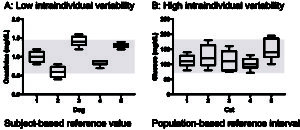Subject- (intraindividual) versus population (interindividual) variability in laboratory test results: Blood samples were taken on 8 different days from 5 dogs and 5 cats for measurement of creatinine (A) and glucose (B), respectively. Box and whisker plots for each dog, with medians (line within box) and minimum and maximum (whiskers) were created. The gray shaded area represents the population-based reference interval for each test.
For creatinine, the variation within dog (width along the Y-axis between the top and bottom whisker for each dog) is lower than the variation between dogs (width along the Y-axis spanning the top whisker and bottom whisker from all dogs combined). This indicates that the variation within animals is less than the variation in the group or population and subject-based reference values are appropriate to use. In contrast, for glucose, the variation within each cat is as great or greater than the variation between cats, indicating population-based intervals are appropriate.
Note how some animals have results that are above or below the reference interval on a few occasions. All of this variation reflects the combination of natural biological and analytical variation.

